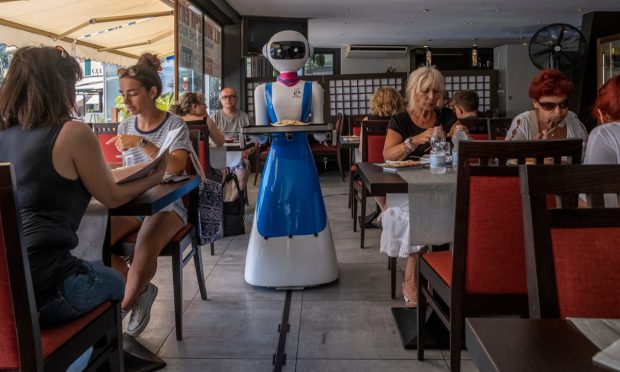Restaurants Tapping Robot Servers Risk Repeating Past Mistakes

Table-service restaurants are turning to robotics to weather labor challenges, but it is too soon to say whether these robots are the waitstaff of the future. A video posted to TikTok in late November showed a robotic server at a Denny’s location, drawing mixed responses from viewers, many of whom were unhappy to see human servers replaced with a machine.
The robo-waiter appears to be one of Bear Robotics’ service models, the same kind that is being piloted at 10 Chili’s locations, per a late October announcement from Nicole Cipani, instructional designer at Brinker International. Robotic waiters are currently being tested all around the world, from Canada to Australia to Japan.
Read more: Robots Take Over Major Casual Dining Chains
The Flip Side
This is far from the first time that restaurants have tried using robotic servers, though technology has advanced since earlier attempts. In 2016, for instance, the Shanghaiist cited a report from Chinese language newspaper Workers’ Daily indicating that Chinese restaurants’ attempts at implementing robotic waitstaff had failed, with a couple of the establishments in the space closing down entirely and another getting rid of all but one of its robotic servers. The report attributed the failure of these attempts to the robots’ inability to keep food steady, to pour hot liquids and to take orders.
“The robots can attract plenty of customers, but they definitely can’t reduce the need for human labor,” commented the owner of one of these restaurants at the time.
The cost savings were not enough to justify these robots’ poor performance, given that purchasing and maintaining the machines, while cheaper than hiring humans, was no small cost.
It is possible that robotics technology has advanced to the point where today’s attempts could be more successful, but recent news gives cause for doubt. For instance, in June, SoftBank discontinued the production of Pepper, its humanoid service robot, after the product proved less popular than expected.
Related news: SoftBank Puts ‘Pepper’ Robot on Hold as Bot Biz Does Some Soul-Searching
By the Numbers
In October, there were 11.5 million employees in food services and drinking places, according to U.S. Bureau of Labor Statistics (BLS) data, down 5% from the same period in 2019. While this may seem like a relatively modest decrease, the figure does not reflect changes in demand, and the rise in digital ordering has called on restaurants to meet more of consumers’ food needs than ever.
In fact, according to data from PYMNTS’ How We Eat Playbook, created in collaboration with Carat from Fiserv, which featured a census-balanced survey of more than 5,200 U.S. adults, consumers now are 31% more likely to buy meals for delivery or pickup than they are to dine on-site.
See also: Up for Grabs: Restaurants and Grocers See Path to Picking up 200M New Customers
Additionally, according to BLS data on job openings from September, the most recent month on record, quit rates for the accommodation and food services industry were up 40% year over year, and job opening rates grew more than twofold.
